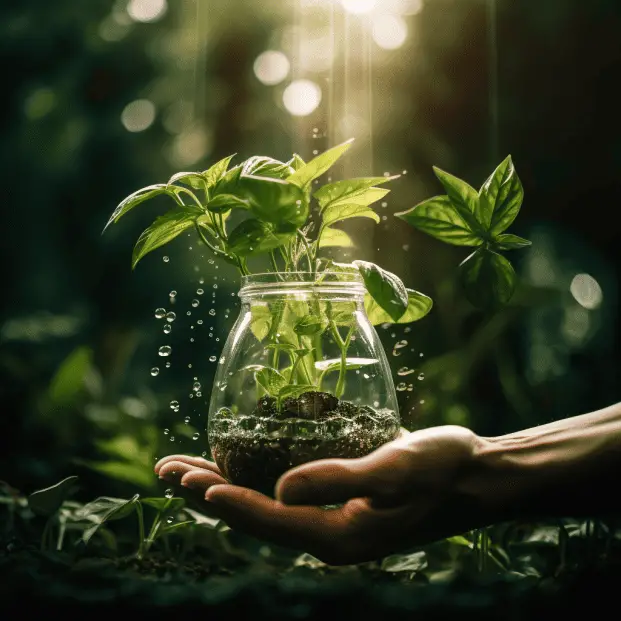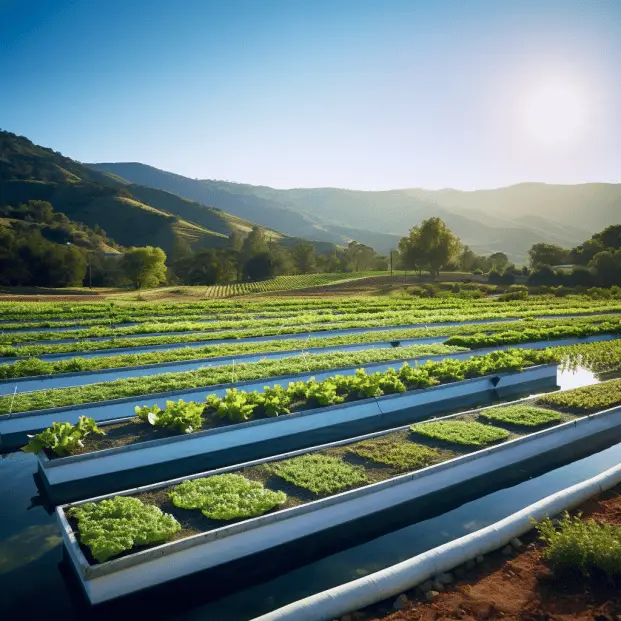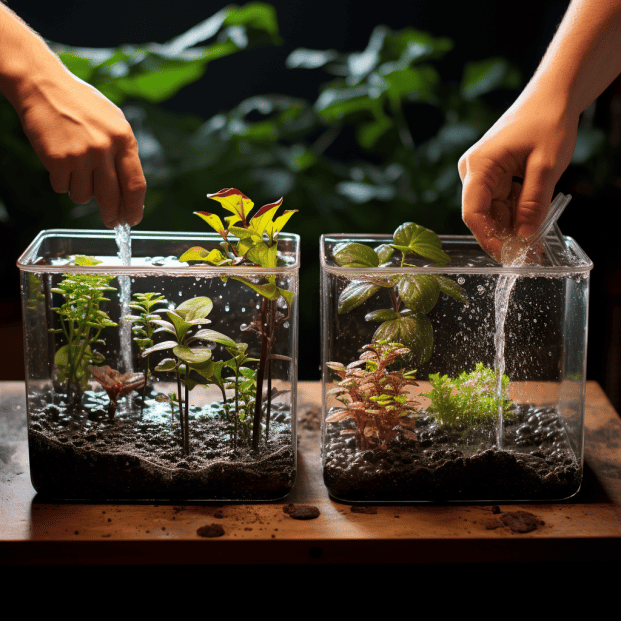Can you go from hydroponics to soil? Well yes, but it’s not as simple as digging a hole and dropping in your plants.
As an avid hydroponic (1) gardener, I’ve experimented with transitioning to soil with mixed results.
To avoid wilted, shocked plants, you need to gradually acclimate roots and monitor moisture levels closely.
Let me share the skinny on this tricky changeover.
Shifting long-term hydroponics plants into soil can be risky business.
Imagine moving from a nice hotel to a leaky, drafty hut! But with my tips to gently coax roots into their new home, you can stick the landing.
From secrets for preventing transplant shock to ideal soils, you’ll have all the intel to swap systems successfully.
In this guide, I’ll use my trials and many errors to show you how to smoothly transition hydro to soil.
You’ll learn warning signs of struggling plants, tweaks to get picky roots settled, and more.
With my guidance, you can discover the best of both growing worlds.
Get ready to expand your green thumb skills!
Thinking hydroponics plants can’t take to soil? Think again! Just follow my transition tips, and you’ll quickly have flourishing gardens in both systems.
Let’s start an easy, enlightening changeover.
Your plants will thank you.
KEY TAKEAWAY
Can you go from hydroponics to soil?
Yes, you can transition from hydroponics to soil cultivation by carefully adapting plant care techniques and ensuring a smooth adjustment process.
The Feasibility of Transitioning from Hydroponics to Soil
Many hydroponic growers eventually ponder trying traditional gardening in soil.
But is transitioning plants from water to dirt truly feasible? With careful preparation and adjustments, the changeover can definitely succeed.
Let’s examine how to smoothly shift systems.
Plants accustomed to hydroponics can suffer major transplant shock if roots are suddenly shoved into soil.
The key is taking a gradual, gentle approach over 2-4 weeks to help them acclimate.
Start by mimicrying soil conditions using a light mix of perlite and coco coir in the hydro system, before moving plants into partial shade outdoors.
This allows roots to adjust while minimizing stress.
Only introduce to soil once new root growth is visible.
Use a loose, well-draining potting mix without heavy compost to avoid saturating tender roots.
Keep the soil moist but not soaked as plants adapt.
Monitor for signs of struggle like wilting and leaf drop.
Be prepared to tweak soil composition, increase humidity, and provide supports until plants harden off.
Patience is essential!
While demanding care and vigilance, transitioning hydroponic plants to soil can expand your gardening horizons.
Take it slow and steady for happy roots and bountiful harvests.
Curious about comparison between hydroponic and traditional soil gardening? Check out the article.
Overcoming Challenges: Moving Plants from Water to Soil

Switching plants from hydroponics to soil poses some unique challenges.
Developing root systems must adapt to draw nutrition from dirt rather than water. (2)
Here are common issues and how to address them.
Moisture management is critical, as hydroponic roots are accustomed to constant bathing.
Allow the soil to partially dry between waterings, but don’t let it get bone dry.
Use your finger to test moisture near roots.
Prevent shock by using humidifiers, cloches, and shading while plants establish.
Gradually acclimate them to lower indoor humidity and full sun outdoor conditions.
Amend soil with extra perlite or coco coir to retain moisture while improving drainage, allowing tender roots to access water without drowning.
Harden plants off gradually over weeks before full exposure to the elements, just like you would seedlings.
Let them build tolerance to shifts in temperature, humidity, and light levels.
With attentive care to ease the transition, both your plants and gardening skills will thrive as you master hydroponics and soil cultivation techniques.
Transplant Shock: What It Is and How to Manage It

Transplant shock is a major danger when shifting plants between growing systems.
The stress can damage roots, stunt growth, and even kill plants.
Here’s how this disorder develops and prevention tips.
Transplant shock typically occurs when moving plants from a stable optimized environment into a new medium.
Since the roots adapted to certain conditions, the sudden change causes stress and decline.
Symptoms include wilting, leaf curl or drop, stunted growth, and root die off.
Plants divert energy to repairing roots instead of developing normally.
Severe cases may be fatal.
Gradual system transitions are key to preventing transplant shock.
For example, start adding soil to hydroponic reservoirs weeks before moving plants outside to get roots used to the new medium.
Also begin hardening off plants in their new environment well beforehand.
Slowly introduce to more sun, wind, and other elements they must adapt to.
Time is essential.
With attentive, gradual acclimation and monitoring, gardeners can avoid the dangers of transplant shock when changing systems.
Be patient and let your plants tell you when they feel at home.
Step-by-Step Guide: Transplanting Hydroponic Plants to Soil
Transitioning hydroponic plants to soil can be done successfully by following these key steps I’ve honed over seasons of system switching:
6-8 weeks before moving, begin using clay pebbles or a light, sterile soil mix in reservoirs to acclimate roots to solids.
3-4 weeks out, move plants to partial or dappled sun to adapt from indoor lighting.
Allow soil surface to dry between waterings.
1-2 weeks before transplanting, replace water with a mix of sterile potting soil and coco coir or compost.
Frequently test moisture near roots using your finger.
On transplant day, gently loosen root balls under running water to remove residues.
Allow to mostly dry before placing in new container.
Select a potting mix with extra perlite or sand to improve drainage.
Start plants in small containers to control moisture levels.
Initially provide significant shading while plants establish over 2-4 weeks.
Slowly expose them to more sun as they harden off.
With a steady, phased approach, both your plants and gardening skills will thrive in the transition between hydroponic and soil growing.
Weighing the Benefits and Risks of Transitioning Methods
Transitioning plants from hydroponics to soil offers exciting benefits but also poses real risks.
As an experienced grower of both systems, let me share an in-depth look at the advantages and challenges you should weigh when considering this swap.
Potential perks include discovering which crops thrive better in soil, saving on electricity costs of hydroponics, and gaining experience with traditional gardening techniques.
Transferring flowering or fruiting plants to soil can boost yields.
Outdoor growing also brings free sunshine and rainfall.
However, major risks are present too.
Transplant shock from abrupt changes in moisture, nutrients and environment can significantly set back or kill plants.
Vigilance is required to prevent problems like root rot in saturated soil.
Pests attracted to the rich soil can attack formerly protected plants.
The switch requires weeks of gradual system blending, hardening off, and close monitoring to give sensitive roots time to adapt.
Some plants like lettuces may never take to soil as well.
And benefits must be weighed against the extra effort required.
There is no universally right choice, but rather what suits your specific goals and plants best.
With prudent precautions and realistic expectations, transitioning between systems can let you discover the ideal growing medium for your greens and gardening skills.
Which Plants Thrive: Hydroponic-to-Soil Transplant Suitability
When selecting hydroponic plants to transplant into soil, some species will readily adapt while others struggle badly.
Here are factors determining which are best candidates for a successful switch.
Plants with larger, heartier root structures like tomatoes, peppers and cucumbers tend to transition better than delicate greens and herbs.
But even seedlings and young plants bounce back well if carefully acclimated.
Varieties that naturally thrive in your target outdoor growing zone make the changeover much smoother.
Also pick pest and disease resistant types to reduce soil risks.
For the best results, focus on transplanting when plants are at a less vulnerable stage between seedling and full maturity.
Avoid upheaval right at harvest time.
Research your specific plant species’ preferences and tolerances to assess transplant suitability.
Heirloom and hybrid types of the same vegetable may handle the shift differently.
While any healthy hydroponic plant can potentially move to soil with proper care, choosing suitable candidates reduces the risks of permanent setbacks or losses during this sensitive process.
Evaluating Hydroponic Systems for Successful Soil Transfers
When preparing to transplant hydroponic plants into soil, some systems give a smoother transition than others.
As an experienced hydroponic gardener, let me compare setups and share advice for picking the right starting point.
Media-based hydroponics using substrates like clay pebbles, perlite or coco coir are ideal launching pads to soil.
Plants’ roots are already growing in a porous solid medium, easing the adjustment.
Deep water culture and nutrient film technique rely on air and water only.
Moving plants directly from these liquid-only systems to soil often causes major transplant shock.
Ebb and flow systems alternate wet and dry cycles that begin prepping roots for soil drying.
But sudden constant moisture can still overwhelm plants.
No matter the starting setup, allow 2-3 weeks before transplanting to shift reservoirs gradually toward soil-like mixes.
And harden-off plants by slowly moving outdoors and reducing humidity.
Focusing on streamlining the exit strategy will let you stick the landing into soil growth.
With smart planning, both your plants and gardening horizons will thrive!
Hydroponic Growth vs.
Soil Growth: A Comparative Analysis
While both effective growing methods, key factors differentiate hydroponic and soil cultivation.
Evaluating these systemic differences helps determine ideal uses for each and strategies for transitioning between them.
Hydroponics offers precise control over nutrients, oxygen and humidity levels for fast, healthy growth, but requires close monitoring.
Soil’s complex ecosystem self-regulates more but has higher disease risks.
Hydroponic plants depend fully on growers for water and minerals.
But soil gardens benefit from some rain absorption and micronutrients.
Transplanting soil plants into hydroponic systems is relatively simple.
But switching hydroponic plants into soil poses many potential pitfalls and requires gradual acclimation.
Soil allows planting outdoors in the ground at larger scales.
Hydroponics is typically used for indoor systems, but compact and stackable.
Both systems can produce bountiful harvests with attentive care.
Choosing the best medium for your crops, environment and gardening style is key to success.
Understanding each method’s strengths and challenges allows blending them effectively.
With experience in both hydroponic and soil growing, the future possibilities are wide open!
Conclusion
Now you’ve got the inside scoop on transitioning from hydroponics to soil successfully.
With time, care, and vigilance, your plants can thrive in their new dirt home.
Use the step-by-step process I outlined to gently acclimate roots and find the right soil blend.
Monitor moisture diligently as plants adjust.
And most importantly, have patience! Change is hard, even for plants.
The possibilities are now wide open to experiment with both hydroponic and traditional gardening.
Try turning your favorites into houseplants or vice versa.
Mix and match systems to find what works best for each crop.
The green growing world is your oyster!
I hope these tips help your plants adjust smoothly when transitioning between hydro and soil.
Just take it slow, listen to your plants, and enjoy watching them flourish in their new medium.
Until next time, happy growing!
References
- https://www.nal.usda.gov/farms-and-agricultural-production-systems/hydroponics
- https://houseandsprout.com/garden/water-roots-to-soil-roots/
Related Articles
- https://tophydroponicgarden.com/hydroponics-vs-traditional-gardening/
- https://tophydroponicgarden.com/what-are-the-benefits-of-hydroponics/
- https://tophydroponicgarden.com/hydroponics-for-beginners/
Was this helpful?

Crystal Erickson is an agriculture enthusiast and writer with a passion for sustainable farming practices and community development. Growing up on a family farm in rural Iowa, Crystal developed a love for the land and a deep appreciation for the hard work and dedication required to make a farm successful.
After completing a degree in Agriculture and Environmental Science from Iowa State University, Crystal began her career as an agricultural journalist, covering stories and issues related to modern farming practices, crop management, and livestock production. She quickly established herself as a respected voice in the industry, known for her insightful reporting and thoughtful analysis.
Over the years, Crystal has written for a variety of publications, including Farm Journal, Successful Farming, and Modern Farmer, as well as contributing to several academic journals focused on sustainable agriculture and community development. Her work has been recognized with numerous awards, including the Iowa Farm Bureau’s Young Farmer Achievement Award and the National Association of Farm Broadcasting’s Farm Broadcaster of the Year.


